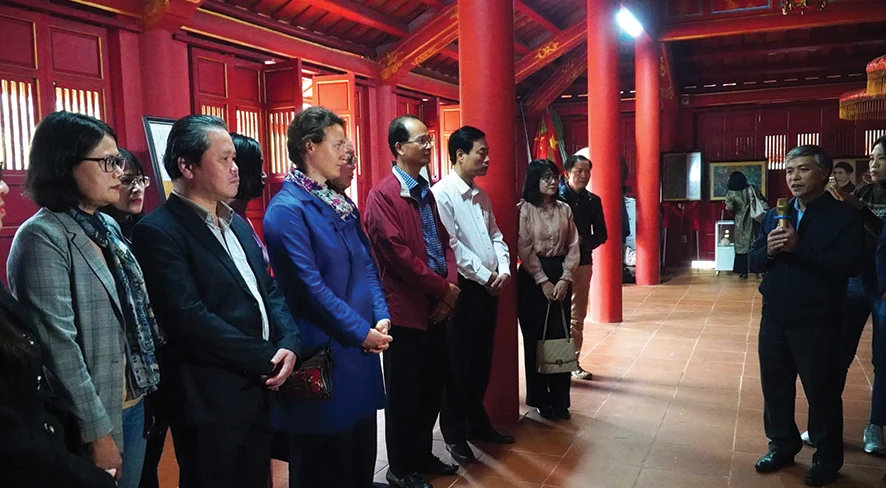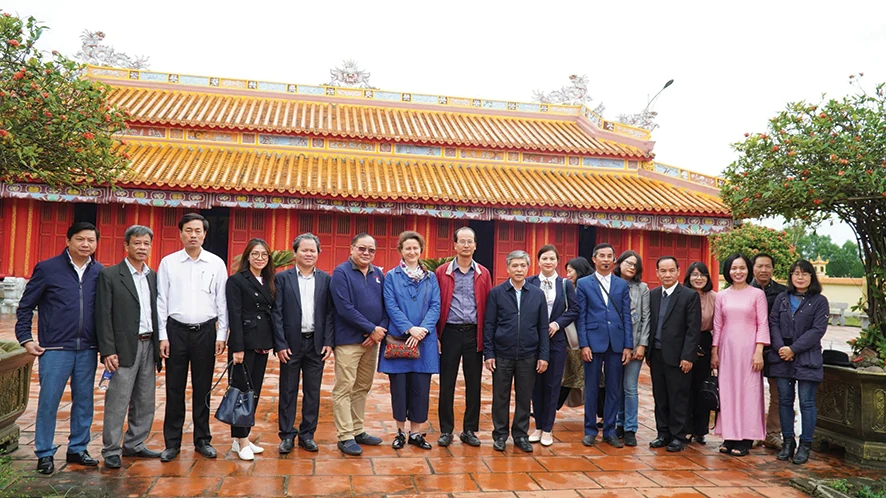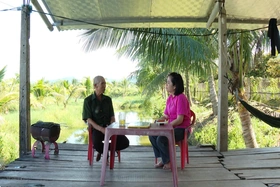{title}
{publish}
{head}
Throughout Vietnam’s long struggle against foreign invaders, Cam Lo has stood as a proud land of patriotism, resilience, and loyalty.
Cam Lo, often referred to as the “land of gentle mist”, has nurtured revolutionary movements and patriotic causes.
The ordinary people here, humble and hardworking, became soldiers and heroes in the fierce battles for national freedom.
This small district in Quang Tri Province holds a special place in national history, having twice been chosen for the vital role of “Capital of Resistance.”

Chairman of the Cam Lo District People’s Committee Tran Anh Tuan makes an introduction about the King Ham Nghi Temple. Photo: Thanh Hai
The first time was in 1885, when young patriotic King Ham Nghi issued the Can Vuong Edict calling on scholars and citizens to rise up against French colonial rule. He did so from Tan So Fortress, located in Cam Chinh Commune.
Later, during the American War, the Provisional Revolutionary Government of the Republic of South Vietnam chose Vinh Ninh Citadel in Cam Lo Town as its headquarters, marking the district’s second time as a revolutionary capital.
In 1776, scholar Le Quy Don described Cam Lo’s geopolitical importance in his book Phu Bien Tap Luc: “Cam Lo Commune, part of Dang Xuong District, lays along the upper stream of the Dieu Ngao River, connected to the East Sea at Cua Viet, and bordering Laos to the west. It is a critical junction for trade and military routes with neighboring regions and tribes.”
Long before the Communist Party of Vietnam was founded, Cam Lo had already become a center for patriotic gatherings and revolutionary ideas in the late 19th and early 20th centuries.
To prepare for long-term resistance against the French, the Nguyen Dynasty built the mountain fortress of Tan So in Cam Chinh Commune from 1883 to early 1885.
After the fall of Hue Citadel in July 1885, King Ham Nghi issued the Can Vuong Edict at this fortress, calling for military assistance from patriots and sparking a nationwide uprising that lasted over a decade.
After King Ham Nghi was captured and exiled to Algeria in 1888, many patriotic scholars continued the resistance in secret. One key location was the silk house in Tan Tuong, Cam Thanh Commune, where revolutionaries raised silkworms to mask their operations.
This site later became one of the first three Communist Party cells in Quang Tri Province and the official birthplace of the Provincial Party Committee in November 1930.
During the wars against French and American forces, Cam Lo’s strategic location along Route 9, a key corridor connecting North and South Vietnam as well as Laos, made it a hotspot of fierce conflict.
The area witnessed countless battles, with famous sites like Hill 241 (Carol), Dau Mau, Fuler, Dong Toan, and Ba Ho becoming legendary for their resistance efforts. Local people, alongside liberation forces, played a crucial role in defeating enemy strongholds.
In July 1964, the Quang Tri Provincial Party Committee launched the Dong Khoi (Total Uprising) movement in Cam Chinh and Cam Nghia communes.
The movement quickly spread, breaking enemy control and returning power to the people.
This movement laid the groundwork for coordinated attacks that eventually led to the liberation of Quang Tri Province on May 1, 1972. Quang Tri was the first province of the South Vietnam to be liberated.

Dr.Amandine Dabat (seventh from left), descendant of King Ham Nghi, visits the king’s temple in Cam Chinh Commune, Cam Lo District. Photo: Thanh Hai
After liberation, Cam Lo was chosen as the headquarters for the Provisional Revolutionary Government of the Republic of South Vietnam from 1973 to 1975. It became a symbol of peace and national unity.
During this period, the government welcomed 49 international delegations and ambassadors, including notable guests like Cuban leader Fidel Castro and French Communist Party General Secretary Georges Marchais.
With deep patriotism and strong revolutionary traditions, the people of Cam Lo worked tirelessly to protect the government and engage in diplomacy.
On June 6, 1973, a major public ceremony was held to inaugurate the government headquarters, attended by international friends from around the world.
After national reunification in 1975, the government completed its historical mission.
Today, the former headquarters site has been preserved and honored as a special historical relic.
It stands as a reminder of Cam Lo’s proud legacy, inspiring future generations to cherish peace and contribute to the nation’s development.
Building on its heroic past, Cam Lo has become the first district in Quang Tri Province to meet the standards of a new-style rural district.
The authorities and people of the district now aim to become a model district with sustainable agriculture and clean, green living environments, a truly livable countryside.
Former Vice President Nguyen Thi Binh, who also served as Foreign Minister of the Provisional Government, once said: “Time and dust may fade the footprints of history makers, but the sacred values of humanity’s fight for freedom and independence will forever endure.”
Those sacred values continue to guide Cam Lo as it looks to a bright and prosperous future.
Thanh Hai – Huy Anh

QTO - Not letting summer slip by in vain, many students in Quang Tri have taken the initiative to teach English to younger children. Through each lesson,...

QTO - Returning from the northern border front with a 2/4 disability, it seemed his journey of service had come to an end. Yet, this wounded soldier began...